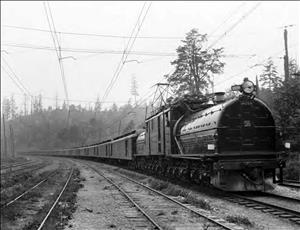This is an account by Stanley Willhight (b. 1914) of the Willhight family's journey to Vashon Island, and the sight of Silk Trains (trains transporting bales of silk) in Smith Cove. It is excerpted from a December 12, 1993 interview conducted by Marian Arlin for the Cedar River Watershed Oral History Project. Stanley Willhight worked for Seattle City Light at their Cedar Falls facility.
Excerpts From the Interview
"My grandfather's name was Thomas Jefferson Willhight. He was in the Union Army in the cavalry during the Civil War. He served from 1862 to 1866 in the Army, and then he went to Illinois. He served in Arkansas during the Civil War.
"He was 16 or 17. His step-father was an Englishman from London and he joined the Union Army also. They joined the Army at the same time. My mother's father joined the 9th Iowa Volunteer Cavalry. They were both in the Civil War.
"I was 18 years old when he died. He lived long enough for Roosevelt to become president. He had lived during the lifetime of 22 presidents, can you imagine? He wasn't so old, but they apparently didn't have these long terms and all that sort of thing and died in office and stuff like that.
"He was born in 1846. After the war first he worked in the big pottery plant at Fairport, Iowa. I have some of his work around. Then he went to Illinois and met his bride. She was a descendant of Hugenots who came to Maine in 1630.
Coming to Vashon
"After Illinois they went to Iowa, then they went to South Dakota and wheat farmed, and that was no good. Finally they came out to Vashon Island. The Willhights were one out of five first settlers on Vashon Island. They settled Vashon in 1883.
"Vashon is so close to the mainland. From my grandfather's porch, his kitchen windows, you could see all of Seattle. You even could see the passage to Tacoma, Alki Point, Elliott Bay, Space Needle, everything right from there.
"He bought 40 acres and became a fruit orchardist. You will see on those letters or cards, it says Fairview Ranch. That was the name of the place. I wish I had it. The house is still there. My other grandfather's house is still there on Vashon.
"It is almost unrecognizable because it has been remodeled, but I know where it is. He had 320 acres.
Early Days and Silk Trains
"I was born on Vashon Island on May 13, 1914. About 1916 my father and mother and the family moved to Cedar Lake where we lived until shortly before 1919. My mother died that year. We ... returned to Vashon because of her illness.
"I remember chiefly the silk trains from Pier 90 at Smith Cove. When I moved into Seattle with my aunt, my mother's sister, I just learned everything. She took me to everything that was going on. When there was a ship in Seattle on its maiden voyage and so on and open to the public, we went through it. If there was a silk shipment coming out of or going to Smith Cove, trains along there, we went and saw it.
"That's where I saw it, at Smith Cove. They were bringing these cars, they looked like passenger cars, not freight cars, they were like a main line passenger car only all closed, and it stretched the whole line along Smith Cove on the tracks, right alongside the warehouses.
"The Admiral Line would come in with these silk shipments and the raw silk was baled like cotton, the most beautiful stuff you ever saw, in huge bales, and they were pure canary yellow, just rich, and they glistened because they were silk. You could see these big ends.
"They would have them piled in those warehouses at Smith Cove right up to the roof. As soon as they would get them unloaded from the ship they would start loading those trains and they were out of there.
"They had precedence over everything, passengers, everything. They went fast and they had the right-of-way all the way from the East Coast to the mills. Those silk bales I don't know how much they must have weighed.
"It was money to get them into textiles. It is like the tea races to England. The ones that got there with it first. There were other ports along the coast where I suppose silk shipments were coming in from other parts of the Orient. Boy, they were out of there, I'll tell you.
"They came quite frequently. We would go out along Golden Gardens along the Sound where they run and see them go out the Milwaukee or the Great Northern through Renton. They had right-of-way over all the traffic. It was really a sight to see that stuff baled."

